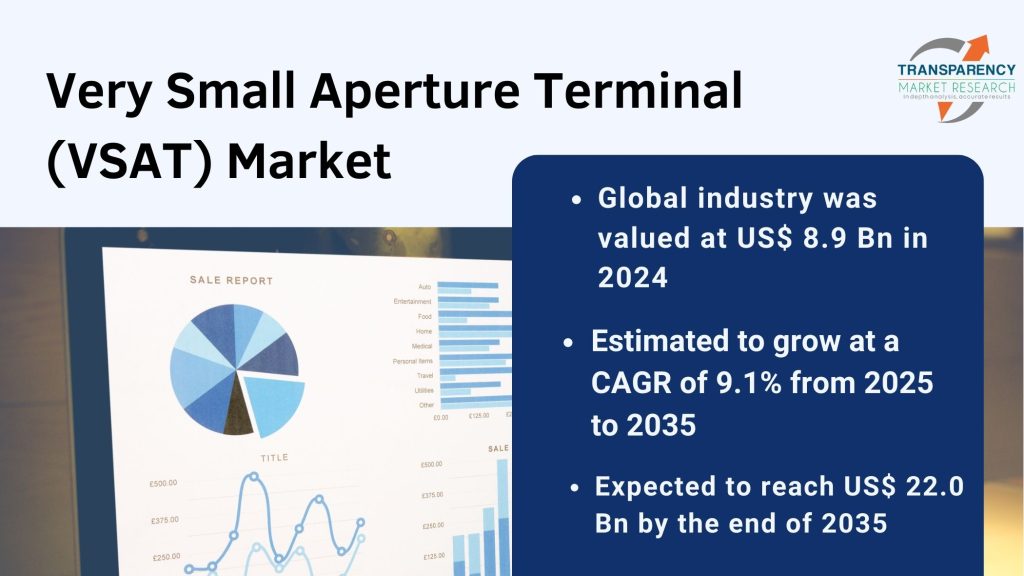
Wilmington, Delaware, Transparency Market Research Inc. – , Feb. 21, 2025 (GLOBE NEWSWIRE) — The global Very Small Aperture Terminal (VSAT) market (VSAT(매우 작은 조리개 터미널) 시장) is valued at US$ 8.9 billion in 2024 and is projected to expand at a CAGR of 9.1% from 2025 to 2035, reaching an estimated US$ 22.0 billion by the end of the forecast period.
Introduction: The Growing Demand for VSAT Solutions
The VSAT market is undergoing transformative growth, driven by an escalating demand for reliable, high-speed satellite communications in remote and underserved locations. As industries increasingly rely on uninterrupted connectivity for mission-critical operations, VSAT technology is being widely adopted in sectors such as telecommunications, defense, maritime, oil & gas, and enterprise networking. This surge is further fueled by the expansion of Internet of Things (IoT) applications and the need for a secure, global communication network.
Request a Detailed Sample PDF Brochure – https://www.transparencymarketresearch.com/sample/sample.php?flag=S&rep_id=86458

Industry experts assert that the growth of the VSAT market is primarily driven by the rising demand for reliable connectivity in areas where terrestrial networks are limited or non-existent. VSAT systems offer an optimal solution with their small, portable dish antennas—typically ranging between 0.75 meters and 3.8 meters—that facilitate two-way data transmission. These systems support diverse applications including internet access, corporate networking, telemedicine, and emergency-response communications.
Advancements in high-throughput satellites and the deployment of low Earth orbit (LEO) satellite networks are further enhancing VSAT capabilities by reducing latency and lowering bandwidth costs. The increasing reliance on dedicated bandwidth systems—accounting for 64.1% of the market in 2024 ensures constant, high-quality connections, especially during peak usage periods.
Market Overview: A High-Growth Industry
The global VSAT market is projected to grow significantly over the next decade, driven by:
- Rising Demand for Rural & Remote Connectivity – Expanding broadband access in underdeveloped regions is fueling adoption.
- Growth in Maritime & Aviation Communications – Real-time connectivity for ships, aircraft, and offshore operations is increasing.
- Advancements in LEO (Low Earth Orbit) & MEO (Medium Earth Orbit) Satellites – These next-generation satellite networks are reducing latency and improving speed.
- Government & Military Investments – Secure, high-bandwidth VSAT networks are essential for defense operations, surveillance, and disaster response.
- 5G Integration with Satellite Networks – The fusion of 5G and VSAT technology is revolutionizing global connectivity.
Competitive Landscape: Key Players Dominating the VSAT Market
Several leading companies are shaping the future of VSAT technology, driving innovation and expanding market reach. Key players include:
- Hughes Network Systems, LLC – A leader in broadband satellite services and VSAT solutions.
- Viasat Inc. – Specializes in high-speed satellite internet and secure communication networks.
- Inmarsat Global Ltd. – Focuses on maritime, aviation, and government VSAT connectivity.
- Gilat Satellite Networks – Known for cost-effective, high-performance VSAT solutions.
- Cobham plc – Provides VSAT antennas and mobile satellite terminals.
- SES S.A. – Expanding global satellite coverage with innovative VSAT technologies.
- Intelsat – Enhancing global broadband connectivity via satellite networks.
Key Market Developments
- August 2023: Botswana Telecommunications Corporation Limited (BTC) partnered with Botswana Communications Regulatory Authority (BOCRA) to expand and upgrade its network in the Northwest region, transitioning from 2G to advanced 4G/LTE connectivity.
- July 2023: Mascom Wireless Botswana (Pty) Ltd. acquired 100% of the issued share capital of MTN Business Solutions Botswana, strengthening its market position.
Get Customized Insights & Analysis for Your Business Needs: https://www.transparencymarketresearch.com/sample/sample.php?flag=S&rep_id=86458
Key Growth Drivers
- Rising Demand for Reliable Connectivity:
The need for uninterrupted communications in remote regions is critical for industries operating in areas with limited terrestrial infrastructure. - Expansion of IoT Applications:
IoT integration in sectors such as agriculture, energy, and industrial operations is boosting the demand for VSAT solutions that offer precise, real-time data monitoring and analytics. - Mission-Critical Communications:
Sectors like maritime and oil & gas are increasingly leveraging VSAT systems for secure, real-time connectivity, ensuring operational efficiency and safety.
Regional Outlook
Leading Region: East Asia
East Asia emerged as the most attractive region in 2024, driven by rapid technological advancements, robust digital infrastructure, and a growing demand for high-speed internet. Major markets such as China, Japan, and South Korea are at the forefront of deploying VSAT solutions to empower telecommunications, broadcasting, and maritime operations.
Challenges & Market Constraints
- High Initial Investment Costs – Deploying VSAT infrastructure can be capital-intensive.
- Regulatory & Spectrum Licensing Issues – Government regulations may limit expansion in some regions.
- Competition from Fiber Optic Networks – Terrestrial broadband alternatives pose challenges in urban areas.
- Latency & Bandwidth Limitations – While LEO and MEO satellite networks are improving speeds, traditional GEO satellites still have latency concerns.
Market Segmentation
The global VSAT market is segmented across several dimensions:
- By Offerings/Components:
- Hardware/Equipment (e.g., antennas, block upconverters, amplifiers)
- Services (e.g., managed support, professional support, connectivity services)
- By Frequency:
- C-Band, X-Band, Ku-Band, Ka-Band, Others
- By Type:
- Dedicated Bandwidth VSAT System
- Shared Bandwidth VSAT System
- By Platform:
- By Network Architecture:
- STAR Topology, MESH Topology, Hybrid, Others
- By Design Type:
- Rugged VSAT, Non-rugged VSAT
- By Application:
- Broadband Networks, Voice and Video Communications, Broadcast, Private Network Services, Others
- By End-User:
- Individual and various Industry Verticals (BFSI, Tourism & Hospitality, Agriculture, Oil & Gas, Retail, Manufacturing, Education, Mining, Government, etc.)
Future Outlook: Where is the VSAT Market Headed?
The VSAT market is poised for significant transformation over the next decade, with growth driven by:
- Expansion of 5G-Enabled Satellite Networks – Merging terrestrial and space-based networks for seamless global connectivity.
- Increased Government Investment in Space Technology – Growing funding for secure military and civil VSAT applications.
- Smart VSAT Solutions for IoT & Edge Computing – Enhancing connectivity for autonomous vehicles, remote AI processing, and industrial automation.
- Surge in Maritime and In-Flight Connectivity Demand – Airlines and shipping industries boosting investments in real-time satellite communications.
Purchase the Full Market Report Today: https://www.transparencymarketresearch.com/checkout.php?rep_id=86458<ype=S
Frequently Asked Questions
- How big was the global very small aperture terminal (VSAT) market in 2024?
- The global VSAT market was valued at US$ 8.9 Billion in 2024.
- How much growth is the VSAT industry expecting during the forecast period?
- The market is expected to grow at a CAGR of 9.1% from 2025 to 2035.
- What are the key factors driving the demand for the VSAT market?
- Key drivers include the growing demand for reliable connectivity and the expansion of IoT applications.
- Which segment contributed the largest share of the VSAT business in 2024?
- The dedicated bandwidth VSAT system accounted for the major share in 2024.
- Which region is more attractive for VSAT vendors?
- East Asia is the most attractive region, driven by rapid technological advancements and expanding digital infrastructure.
- Who are the prominent players in the VSAT market?
- Notable companies include Botswana Telecommunications Corporation Limited, GlobalTT, Honeywell International Inc., Hughes Network Systems, Liquid Intelligent Technologies, Liquid Telecom, MTN Group, NTvsat, Orange, Paratus Botswana Services, Spacecom, Starlink, Vizocom, Thales Group, Mitsubishi Electric Corporation, and L3Harris Technologies Inc.
Explore Latest Research Reports by Transparency Market Research:
- Automotive Chip Market (자동차 칩 시장) – The automotive chip industry is expected to reach the value of US$ 146.7 Billion by the end of 2034
- Car E-hailing Market (자동차 전자호출 시장)- The car E-hailing market is expected to reach US$ 171.1 Billion by the end of 2034.
About Transparency Market Research
Transparency Market Research, a global market research company registered at Wilmington, Delaware, United States, provides custom research and consulting services. Our exclusive blend of quantitative forecasting and trends analysis provides forward-looking insights for thousands of decision makers. Our experienced team of Analysts, Researchers, and Consultants use proprietary data sources and various tools & techniques to gather and analyses information.
Our data repository is continuously updated and revised by a team of research experts, so that it always reflects the latest trends and information. With a broad research and analysis capability, Transparency Market Research employs rigorous primary and secondary research techniques in developing distinctive data sets and research material for business reports.
Contact:
Transparency Market Research Inc.
CORPORATE HEADQUARTER DOWNTOWN,
1000 N. West Street,
Suite 1200, Wilmington, Delaware 19801 USA
Tel: +1-518-618-1030
USA – Canada Toll Free: 866-552-3453
Website: https://www.transparencymarketresearch.com
Email: sales@transparencymarketresearch.com
Follow Us: LinkedIn| Twitter| Blog | YouTube

© 2025 Benzinga.com. Benzinga does not provide investment advice. All rights reserved.


